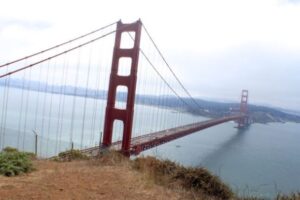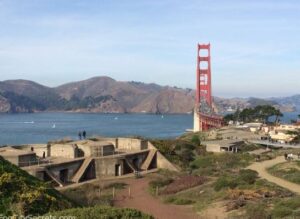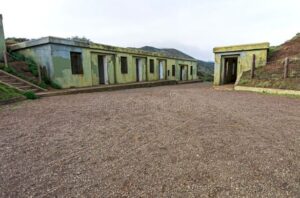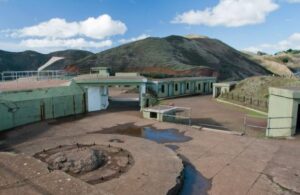
 Battery Spencer was a reinforced concrete Endicott Period 12-inch gun battery, which was located on Fort Baker, Lime Point, Marin County, California. The structure still exists today and is a favorite tourist attraction. The battery was named on Feb 14, 1902, after Major General Joseph Spencer, who was a Revolutionary War hero. Spencer died on January 13, 1789. Construction on the battery began in 1893, and it was completed in 1897. Following its completion, it was transferred to the Coast Artillery for use on September 24, 1897, at a total cost of $110,352.70. It was deactivated in 1942 during World War II.
Battery Spencer was a reinforced concrete Endicott Period 12-inch gun battery, which was located on Fort Baker, Lime Point, Marin County, California. The structure still exists today and is a favorite tourist attraction. The battery was named on Feb 14, 1902, after Major General Joseph Spencer, who was a Revolutionary War hero. Spencer died on January 13, 1789. Construction on the battery began in 1893, and it was completed in 1897. Following its completion, it was transferred to the Coast Artillery for use on September 24, 1897, at a total cost of $110,352.70. It was deactivated in 1942 during World War II.
The battery was originally part of the Harbor Defense of San Francisco. The harbor was likely one of the most vulnerable entrances to San Fransisco, and in the early days of the country, when radar didn’t exist, it was hard to tell if an enemy was sneaking into the harbor, especially a submarine. Battery Spencer was a concrete coastal gun battery with three M1888 12-inch guns mounted on long range Barbette M1892 carriages. It was constructed on top of the five front emplacements of Battery Ridge. Back in the early 1900s, Battery Spencer was one of the main protection points for the San Francisco Bay. It featured multiple lookout points that were operated by the military and a few buildings for housing the generators and shells. It was used on and off until World War II when a lot of it was scrapped for war efforts.
The guns were mounted on 3 emplacements. Emplacements #1 and #2 were separated by a magazine with two shell rooms, a powder room, and a shell hoist room. Emplacement #3 had its own shell room, powder room, and hoist room. Spencer Battery was a two-story battery with the magazines on the lower level and the gun emplacements on the upper level. The missiles, or more likely cannon balls at first, were originally moved from the magazine level to the loading level with hand powered projectile hoists. In 1908, the hand powered hoists were replaced with electric Taylor-Raymond front delivery hoists. The new hoists were put into service on September 30, 1908. There were no powder hoists at Battery Spencer, meaning that gun powder had to be moved by hand.
Along the access road that runs north of Emplacement #1, was the BC Post and a separate building that had four rooms. The rooms consisted of a CO room, a guard room, an oil room, and a large 12′ by 43′ plotting room. All of these were used to plan any defensive action taken by the soldiers stationed at Battery Spencer. Two other buildings across the road completed the battery. One housed the tools and rammers, the other a latrine building with separate facilities for officers and enlisted. In 1910 the BC post and the plotting room were remodeled and updated. The work was accepted for service on August 5, 1910, at a cost of $1680.68.
When the United States entered World War I, it was decided that the large caliber coastal defense gun tubes should be removed from coastal batteries and sent into service in Europe. First, they were sent to arsenals for modification and mounting on mobile carriages, both wheeled and railroad. Strangely, most of the removed gun tubes never made it to Europe. Many were either remounted at the batteries or remained at the arsenals until needed elsewhere. One gun was removed from Battery Spencer emplacement #3 in 1918 and sent to Battery Chester at Fort Miley. The gun at Battery Spencer was never replaced, and the emplacement was considered abandoned. The carriage remained in place until it was ordered salvaged on January 10, 1927. World War II brought the first large scale scrap drive, and the remaining two guns and carriages were ordered scrapped on November 19, 1942. 

These days Battery Spencer is part of the Golden Gate Recreation Area (GGNRA) administered by the National Park Service. It is a favorite historical attraction, even though no period guns or carriages are in place. The site is also one of the very best views of the Golden Gate Bridge and San Francisco.


Leave a Reply